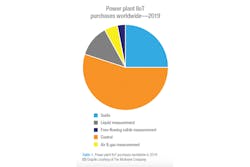The power industry represents a $19 billion annual Industrial Internet of Things (IIoT) market growing at 8 percent annually, according to "IIoT & Remote O&M," a report published by the McIlvaine Company.
The guide segment is growing faster than the others. This segment includes process management software and data analytics. The liquid measurement segment includes steam, which makes it larger than the air and gas measurement segment. Free-flowing solids measurement is needed for coal, fly ash and dry chemicals.
Coal-fired power plants will be the largest purchasers but the gap is shrinking as gas turbine capacity grows. Nuclear plants will continue to rank below coal and gas. The amount of IIoT purchases by solar and wind generators will remain small even though the share of generation by these plants will be growing robustly. Geothermal and biomass plants are individually large purchasers of IIoT products but their share of total generation will
be small.
Between 2018 and 2021 the capacity of coal plants worldwide will grow from 2,440 gigawatts (GW) to 2,600 GW. The average boiler size is 200 megawatts (MW). There are 12,200 existing boilers within these coal plants. The average size of new boilers is 500 MW. So, the number of boilers will grow by 320 during the next three years. This will create substantial markets for guide, control and measure related to environmental upgrades.
India will be retrofitting air pollution control for 60,000 MW of coal-fired capacity. Guide, control and measure products and systems will be required for the flue gas desulfurization, selective catalytic NOx reduction and particulate control systems. The resultant wastewater will be treated with the addition of chemicals based on the measurement of effluent quality. There is a growing interest in third-party operation and maintenance. This option has been made more attractive by the ability to remotely monitor all components, and then continuously analyze performance.
Nuclear capacity will grow from 433 GW in 2018 to 453 GW in 2021. The average reactor has a capacity of 1 GW and many sites have multiple reactors. This means there are less than 500 units and less than 300 sites. Global nuclear power generation is now predicted to grow by 2.3 percent per annum out to 2035. More than 90 percent of the IIoT expenditures will be made by fewer than 50 companies. Thirty-nine percent of these purchases will be made by just three operators and one supplier.
Gas turbine capacity will rise from 1,670 GW in 2018 to 1,890 GW in 2021. The average unit size is 0.1 GW, resulting in 18,900 units in place by 2021. There are thousands of geothermal, biomass, biogas and hydro plants. Most are small.
There are nearly 30,000 industrial boilers in the U.S. However, there are only 350 plants with coal-fired boilers and 2,000 plants with large gas-fired boilers. BASF is one company that operates multiple boilers at dozens of plants throughout the world.
Industrial boilers often provide both power and steam. The IIoT requirements for the combustion, ultrapure water, steam and cooling systems are substantial.
Gas measurement
There will be a substantial increase in purchases of gas measurement devices in the power industry over the next five years. The purchase of instrumentation will expand faster than the construction of new power plants due to the following factors:
- Increased measurement and control at existing plants
- Expansion of coal-fired capacity
in Asia - Expansion of gas turbine combined cycle plant capacity worldwide
- Development of better instruments — which justify replacing existing instruments — or use where instruments were not previously used
- Expansion of the regulatory requirements to measure stack emissions continuously
- Increased number of pollutants to be measured
- Expansion of rules to measure fence line and other ambient pollutants
- Improvements of combustion efficiency with better in-furnace gas measurements
- The top 15 power companies will spend more than $750 million for gas measurement devices in 2022. This includes analyzers to measure CO, CO2, O2, NOx, NH3, SO2, SO3, mercury and dust. The requirements for mass measurement of dust are boosting the market because the cost is considerably greater than the previously required opacity monitors.
The power industry is a major purchaser of IIoT equipment and services. The advent of remote monitoring and third-party operational and maintenance support will allow the world’s expertise to be utilized by developing countries with their growing power needs.
Bob Mcilvaine is the president of the Mcilvaine Company in Northfield, Illinois. Mcilvaine provides market research and technical analyses on power plant purchases. He may be reached at [email protected] or 847-784-0012, ext. 112.


